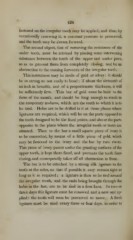Page 428 - My FlipBook
P. 428
424
fastened on the irregular tooth may be applied, and thus, by
occasionally renewing it, a constant pressure is preserved,
and the tooth may be drawn forward.
The second object, that of romoving the resistance of the
under teeth, must be attained by placing some intervening
substance between the teeth of the upper and under jaws,
so as to prevent them from completely closing, and be an
obstruction to the coming forwards of the irregular tooth.
it should
This instrument may be made of gold or silver :
be so strong as not easily to bend ; if about the sixteenth of
an inch in breadth, and of a proportionate thickness, it will
be sufficiently firm. This bar of gold must be bent to the
form of the mouth, and should be long enough to reach to
the temporary molares, which are the teeth to which it is to
be tied. Holes are to be drilled in it at those places where
ligatures are required, which will be on the parts opposed to
the teeth designed to be the fixed points, and also at the parts
opposite to the place where the irregular tooth or teeth are
situated. Then to the bar a small square piece of ivory is
to be connected, by means of a little piece of gold, which
may be fastened to the ivory and the bar by two rivets.
This piece of ivory passes under the grinding surfaces of the
upper teeth, is kept there fixed, and prevents the teeth from
closing, and consequently takes off all obstruction in front.
The bar is to be attached by a strong silk ligature to the
teeth at the sides, so that if possible it may remain tight as
long as it is required ; a ligature is then to be tied around
the irregular tooth, and the ends being brought through the
holes in the bar, are to be tied in a firm knot. In two or
three days this ligature must be removed and a new one ap-
plied : the tooth will soon be perceived to move. A fresh
ligature must be used every three or four days, in order to


